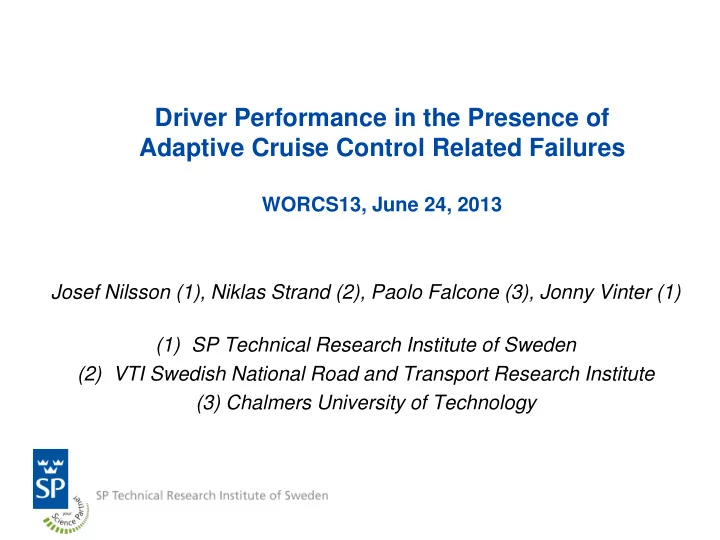

Driver Performance in the Presence of Adaptive Cruise Control Related Failures WORCS13, June 24, 2013 Josef Nilsson (1), Niklas Strand (2), Paolo Falcone (3), Jonny Vinter (1) (1) SP Technical Research Institute of Sweden (2) VTI Swedish National Road and Transport Research Institute (3) Chalmers University of Technology
The SHADES project SHADES - S ystem safety through combination of H MI a nd De pendable S ystems Budget: 1 MEUR Financed by SAFER
Driver assistance systems • Information/Warning Systems – Forward Collision Warning – Lane Departure Warning – Blind Spot Monitoring • Active assistance/Semi automation – Collision Avoidance by Braking – Lane Keep Assist – Adaptive Cruise Control • Full/High automation – Lateral and longitudinal automation – Platooning lateral longitudinal
Focus in this study Driver Vehicle Driver assistance system malfunctions that cause hazards
Questions before the study • What are the safety issues considering failures of an adaptive cruise control system (ACC)? • How do drivers handle failures in an ACC? • How to develop strategies to improve driver controllability?
Experimental setup • Adaptive Cruise Control (ACC) • Driving simulator study • Four failure modes – Unwanted acceleration Lead – Complete brake failure – Partial brake failure – Speed limit violation 2 s • There was no warning indicating a failure • All with the same initial settings – ACC activated Ego – 105 kph (65 mph) – Following leader with a 2 second time-gap – No vehicle in left lane (free to overtake)
Chalmers driving simulator
Driving simulator experiment – Fault injection support Relative Velocity Relative Distance Engine torque Own Velocity Desired Acceleration Desired Acceleration Brake pedal position Set Time-Headway Lower level controller Set Maximum-Speed Upper level controller
Driving simulator experiment – Adaptive cruise control Relative Velocity Relative Distance Engine torque Fault Own Velocity Desired Acceleration Desired Acceleration injection block Brake pedal position Set Time-Headway Lower level controller Fault injection Set Maximum-Speed block Upper level controller Unwanted acceleration Complete brake failure Speed failure Partial brake failure
Participants • 48 participants – 33 men and 15 women – between 25 and 59 years of age – annual driving distance more than 5000 km – no experienced ACC users
Scenario A: Unwanted acceleration Car in front drives at 105 kph (65 mph), ACC in ego car accelerates unintentionally towards vehicle ahead (fails to keep the set distance and speed) Braking or steering Fails to follow leader with a required to avoid collision 2 second time gap
Scenario B&C: Complete and partial brake failure B: Car in front brakes, ACC in ego car does not brake C: Car in front brakes, ACC in ego car brakes less than necessary to avoid a collision Braking or steering required to avoid collision
Scenario D: Speed limit violation Car in front accelerates above speed limit, ACC in ego car also accelerates keeping set distance (2s) but fails to keep set speed limit (110 kph) Following leader with a 2 second time-gap 100 90 110 110 Braking required to avoid speeding
Design Order of scenarios Subjects 1 2 3 n = 4 Practice A B n = 4 Practice B A n = 4 Practice A C n = 4 Practice C A n = 4 Practice A D n = 4 Practice D A n = 4 Practice B C n = 4 Practice C B n = 4 Practice B D n = 4 Practice D B n = 4 Practice C D n = 4 D C Practice * A=B=C=D=Experimental scenario including experimental situation and preceding baseline ** N = 48 *** n = 24 for each experimental scenario
RESULTS
The drivers available strategies when system fails
Scenario A: Ego car accelerates unintentionally • No collisions • Majority used steering • One third slowed down – Six braked – One turned off the ACC using the button • Three drivers got the vehicle unstable which automatically aborted the experiment
Scenario B&C: Brake failures • Both brake failures caused collisions • Partial brake failure caused more collisions than complete failure – But with lower impact speed (36 Complete brake failure kph vs. 82 kph)! • Changing lane most common for drivers with successful outcome Partial brake failure
Scenario D: Ego car accelerates keeping the set distance but fails to keep the set speed limit • Eight drivers did nothing within 30 seconds of speeds above 110 kph • Braking more common than pressing the ACC on/off button
Conclusions • More drivers changed lane than braked to acceleration and brake failures – But note that drivers were always free to change lane • Collisions only occurred in scenarios with brake failures • More collisions for partial brake failure than for complete brake failure – However, impact speed was less for partial brake failure • Comparing brake failures: – Higher controllability for complete brake failure (fewer collisions) – Lower severity for partial brake failure (lower impact speed) Risk = Exposure x Controllability x Severity
Thanks for your kind attention! Questions? jonny.vinter@sp.se
Recommend
More recommend